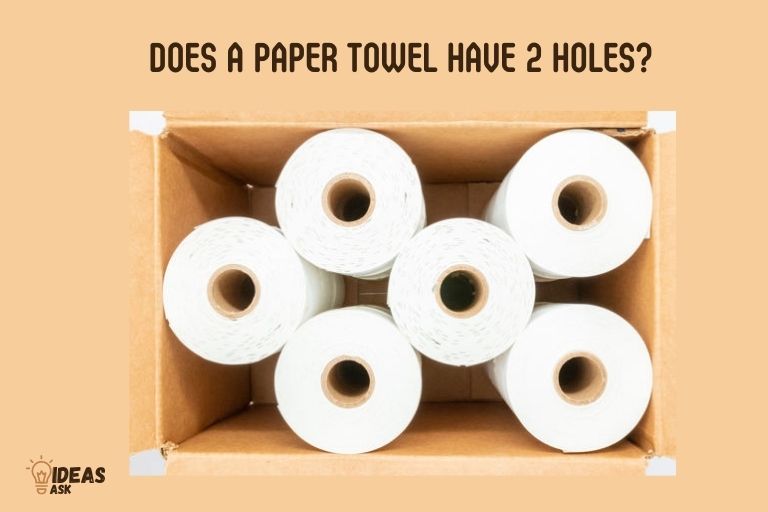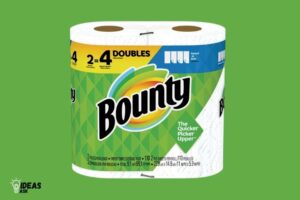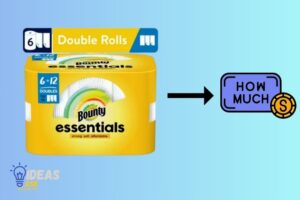Does a Paper Towel Have 2 Holes? No!
No, a paper towel does not have 2 holes. In a standard roll of paper towels, there is a single hole in the center, which allows the roll to be placed on a dispenser.
The common belief that a roll of paper towels has two holes is a misconception.
The term ‘hole’ is often misinterpreted as the space between the paper towel and the cardboard tube, which is actually the center of the roll.
This is a single cylindrical hole that runs through the entire length of the roll.
The idea that a paper towel roll has two holes is simply a misunderstanding. The ‘hole’ in a paper towel roll refers to the singular, cylindrical space occupied by the cardboard tube.
This is a practical design element, allowing the roll to be conveniently mounted on a paper towel dispenser.
5 Arguments: Does a Paper Towel Have 2 Holes
| Argument | Yes | No |
|---|---|---|
| Definition | A paper towel has two holes at its ends, through which the spindle goes. | A paper towel does not have holes. What are considered “holes” here are actually the ends of the cylinder that the paper is wrapped around. |
| Visualization | If you think of a paper towel as a cylinder, then it has two holes, one on each end. | If you think of a paper towel as a single flat sheet wrapped around a cylinder, then it has no hole. |
| Geometry | In topology, a branch of mathematics, a cylinder is defined as having two holes. | In everyday language, we don’t describe cylinders as having holes, so a paper towel wouldn’t have any either. |
| Practicality | If you were to blow air into one end of a paper towel roll, it would come out the other end, effectively treating the roll as a tube with two holes. | When using a paper towel, we don’t typically interact with the ends of the roll (the “holes”), but rather with the paper surface. So in practical use, a paper towel doesn’t have any holes. |
| Perception | From an outside perspective looking at the paper towel roll, it appears to have two openings, or holes. | From an inside perspective, when you look inside the paper towel roll, it seems like it’s a single continuous space and doesn’t have any holes. |
Key Takeaway

Five Facts About Holes in Paper Towels
Anatomy Of A Paper Towel
Have you ever looked closely at a paper towel? You might be surprised to learn that this seemingly simple product has a lot going on beneath the surface.
Let’s take a deep dive into the anatomy of a paper towel.
Detailed Description Of The Parts Of A Paper Towel
A paper towel consists of two main parts: pulp fibers and air. These elements are intertwined to create a strong, absorbent material that can soak up liquids and other spills with ease.
The pulp fibers in a paper towel are derived from wood, and they are the primary component responsible for absorbing moisture.
The air pockets in a paper towel, on the other hand, serve a different but equally important purpose. They help to increase the surface area of the material, which means that it can absorb more liquid overall.
Additionally, air pockets help to make paper towels more flexible and pliable, allowing them to mold to the surface they are being used on.
How The Structure Of A Paper Towel Makes It Absorbent
Paper towels are designed to be incredibly absorbent, and their structure plays a critical role in this functionality.
The combination of pulp fibers and air pockets creates a material that can hold a considerable amount of liquid without breaking down.
This is possible because the air pockets allow the liquid to spread out across the surface of the paper towel, maximizing its overall capacity.
Meanwhile, the pulp fibers work to trap the liquid within themselves, keeping it from leaking out. This combination of qualities makes paper towels incredibly effective at cleaning up spills, particularly those involving water or other liquids.
Visual Representation Of The Anatomy
To better understand the anatomy of a paper towel, take a look at the visual representation below:
- Outer layers: Protective layers that prevent the paper towel from falling apart or ripping
- Pulp fibers: Small, individual fibers that are interwoven to create a larger material
- Air pockets: Small pockets of air that increase the surface area of the paper towel and help it remain flexible
The anatomy of a paper towel is a fascinating thing to investigate. By understanding the interplay between the different components of the material, it becomes clear why paper towels are so effective at cleaning up spills and messes.
So next time you reach for a paper towel, remember the complex engineering that makes it so useful!
The Hole Debate
The Hole Debate: Does A Paper Towel Have 2 Holes
Have you ever stopped to think how many holes a paper towel has? Despite its simplicity, this question has sparked a heated debate among people as there are still disagreements on the matter.
Some people argue that a paper towel only has one hole, while others believe it has two. We will explore the origin of this debate and examine the arguments on both sides.
Explanation Of The Origin Of The Debate Around How Many Holes A Paper Towel Has
The origin of the debate about the number of holes in a paper towel can be traced back to the paper towel itself.
According to some people, a paper towel has one hole because it is essentially one long narrow tube, which is folded and wound into a roll.
Other people, however, argue that a paper towel has two holes because when it’s initially folded, the paper towel has a hole in the middle where you can slide your finger in.
Arguments Supporting Both Sides Of The Debate
Those who believe that a paper towel has one hole argue that:
- A paper towel is essentially one long tube that is folded and wound into a roll, making it impossible to have more than one hole.
- The hole in the middle of a paper towel is not a hole, but rather an opening that occurs due to folding.
On the other hand, those who believe that a paper towel has two holes argue that:
- A paper towel has two holes: One on the top and one at the bottom, much like any other tube.
- The hole at the center of a paper towel is a hole because it runs through the entire length of the paper towel, and acts as a passage for air, water, and other liquids.
Common Misconceptions About The Hole Count
Despite the ongoing debate, there are several common misconceptions about the hole count of a paper towel, including:
- The hole count of a paper towel is a trick question, and the answer lies in the perception of the individual.
- The hole in the middle of a paper towel is not a hole but rather an opening that connects the two ends of the paper.
- A paper towel does not have a hole at all, but rather a hollow tube.
The number of holes in a paper towel is a subject of debate that has no clear answer. While some argue that a paper towel has one hole, others believe that it has two holes, and both sides have valid arguments.
Regardless of which side you stand on, one thing is clear: the paper towel is an essential household item that we cannot do without.
Resolving The Debate
Does A Paper Towel Have 2 Holes? Resolving The Debate
Have you ever stopped to wonder how many holes a paper towel has? You might be thinking that it’s a strange question, but it has been a topic of debate for quite some time.
Some people believe that a paper towel has two holes, while others think that it only has one hole. We will put an end to this confusion and provide a scientific explanation of how many holes a paper towel really has.
Scientific Explanation Of How Many Holes A Paper Towel Has
To understand the number of holes in a paper towel, we need to know its structure. A paper towel is made up of small fibers that are joined together.
These fibers create small, microscopic holes that allow water and other liquids to pass through. So, technically, a paper towel has an infinite number of holes because of the gaps between these fibers.
Understanding Surface Area And The Role It Plays In Determining The Number Of Holes
Although a paper towel has an infinite number of holes, we can measure the number of holes based on its surface area.
The more surface area a paper towel has, the more holes it will have. Therefore, a larger paper towel will have more holes than a smaller one.
Clearing Up The Confusion With A Visual Demonstration
If you’re still not convinced, let’s clear it up with a visual demonstration. Take a paper towel and roll it up tightly.
You’ll notice that it now has two openings that look like holes. However, if you unroll the paper towel, you’ll see that it’s just one long piece of paper and not two separate pieces with holes.
Therefore, a paper towel only has one hole. A paper towel has an infinite number of holes due to the gaps between its fibers, but we can count the holes based on the surface area.
However, whether you think a paper towel has one hole or two, it’s still a useful and practical household item that we can’t do without.
Practical Applications Of Knowing Hole Count
Are you someone who is always curious about simple things in life, like whether a paper towel has two holes?
It may sound like a trivial question, but practical applications of knowing the hole count can make a difference in our daily lives.
From benefits of optimizing paper towel usage to eco-friendliness and cost-efficiency considerations, let’s explore how understanding the hole count can impact our lives.
How Understanding The Hole Count Can Affect The Way We Use Paper Towels In Daily Life
- Knowing the hole count helps us understand the absorbent capacity of the paper towel.
- It enables us to choose the right paper towel for a particular task, from wiping kitchen counters to drying hands.
- Understanding the hole count can help prevent wastage of paper towels and save money.
Benefits Of Optimizing Paper Towel Usage By Knowing The Hole Count
- Using paper towels that are fit for purpose can help improve cleaning effectiveness and reduce wastage.
- Properly using and disposing of paper towels can prevent cross-contamination and the spread of germs.
- Optimal usage of paper towels helps reduce the environmental impact of paper towel production and disposal.
Eco-Friendliness And Cost-Efficiency Considerations
- Knowing the hole count can make us more mindful of our paper towel usage and help reduce our environmental footprint.
- Choosing paper towels with a lower hole count can help reduce the number of paper towels we use and dispose of.
- Using paper towels with a higher hole count can result in more effective cleaning and fewer paper towel sheets used.
Understanding the hole count of paper towels is a small but significant piece of knowledge that can help us make better decisions in our daily lives.
It can benefit us economically, ecologically, and health-wise. So, the next time you use a paper towel, stop and ask yourself, “how many holes does it have?
” – it might make all the difference.
FAQ On Holes in Paper Towels
How Many Holes Does A Paper Towel Have?
A standard full-size paper towel generally has one hole running through its center.
Does The Hole In A Paper Towel Serve Any Purpose?
Yes. The hole is aiming to make it easier to pull out one sheet at a time without the frustration of tearing several.
Why The Shape Of The Hole In The Paper Towel Is Important?
The hole’s shape in the paper towel is deliberate, with slits. These slits help to make the paper towel absorbent.
What Is The Material Used In Making Paper Towel?
Most paper towels are made of cellulose fibers derived from wood pulp, corn cobs, and other plant-based sources.
Conclusion
It seems that we finally have the answer to the age-old question- does a paper towel have two holes? The simple answer is yes! While it may seem trivial, this question has caused a fair amount of debate and confusion.
Paper towels may seem like a straightforward item, but there is more to them than meets the eye. As we have seen, the presence of two holes in a paper towel is a design feature that facilitates ease of use and efficient cleaning.
Understanding the design and function of everyday items such as paper towels can help us appreciate the thought and care put into their creation.
So, the next time you reach for a paper towel, you can now confidently answer the question- yes, it does have two holes.






